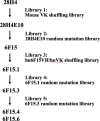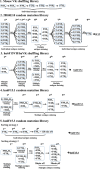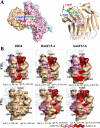Multicolor fluorescence activated cell sorting to generate humanized monoclonal antibody binding seven subtypes of BoNT/F
- PMID: 36048906
- PMCID: PMC9436041
- DOI: 10.1371/journal.pone.0273512
Multicolor fluorescence activated cell sorting to generate humanized monoclonal antibody binding seven subtypes of BoNT/F
Abstract
Generating specific monoclonal antibodies (mAbs) that neutralize multiple antigen variants is challenging. Here, we present a strategy to generate mAbs that bind seven subtypes of botulinum neurotoxin serotype F (BoNT/F) that differ from each other in amino acid sequence by up to 36%. Previously, we identified 28H4, a mouse mAb with poor cross-reactivity to BoNT/F1, F3, F4, and F6 and with no detectable binding to BoNT/F2, F5, or F7. Using multicolor labeling of the different BoNT/F subtypes and fluorescence-activated cell sorting (FACS) of yeast displayed single-chain Fv (scFv) mutant libraries, 28H4 was evolved to a humanized mAb hu6F15.4 that bound each of seven BoNT/F subtypes with high affinity (KD 5.81 pM to 659.78 pM). In contrast, using single antigen FACS sorting, affinity was increased to the subtype used for sorting but with a decrease in affinity for other subtypes. None of the mAb variants showed any binding to other BoNT serotypes or to HEK293 or CHO cell lysates by flow cytometry, thus demonstrating stringent BoNT/F specificity. Multicolor FACS-mediated antibody library screening is thus proposed as a general method to generate multi-specific antibodies to protein subtypes such as toxins or species variants.
Conflict of interest statement
The authors have declared that no competing interests exist.
Figures






References
-
- Rockx B, Corti D, Donaldson E, Sheahan T, Stadler K, Lanzavecchia A, et al.. Structural Basis for Potent Cross-Neutralizing Human Monoclonal Antibody Protection against Lethal Human and Zoonotic Severe Acute Respiratory Syndrome Coronavirus Challenge. J Virol. 2008;82(7):3220–35. doi: 10.1128/JVI.02377-07 - DOI - PMC - PubMed
Publication types
MeSH terms
Substances
Grants and funding
LinkOut - more resources
Full Text Sources
Miscellaneous

